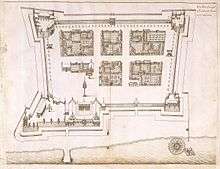Fort Oranje (Ternate)

Fort Oranje is a 17th-century Dutch fort located at the center of Ternate City on the island of Ternate, one of the Moluccas in Indonesia. The fort is the largest in Ternate Island. Fort Oranje was once the capital of Dutch East India Company's trade empire in Asia until it was moved to Batavia.
History

Ternate is a small volcanic island located in Maluku Islands (The Moluccas). It was the center of the powerful former Sultanate of Ternate. The island was once the world's single major producer of cloves,[1] a commodity which allowed the Sultanate of Ternate to become amongst the most powerful Sultanate in the Indonesian region. The sultans of Ternate was in a continuously conflict with the nearby Sultanate of Tidore. At the end of the 15th century, the Ternatese has adopted Islam as their official religion, which was mainly influenced from the Javanese.[2][3]
The first Europeans to arrive in Ternate were the expedition team led by Francisco Serrão. Serrão had been shipwrecked near Ceram and was rescued by local inhabitants. Informed by the local Ternatese, the Sultan brought the survivors to Ternate in 1512 and gave permission to the Portuguese to build a fort. Construction of the fort began in 1522, however relationship between the Portuguese and the Sultan was not good since the beginning of the treaty and deteriorated over time. Following the murder of Sultan Hairun at the hands of the Portuguese, the Ternatese expelled the Portuguese in 1575 after a five-year siege. European power in the region was weak and Ternate became an expanding, fiercely Islamic and anti-Portuguese state under the rule of Sultan Baab Ullah (r. 1570–1583) and his son Sultan Said.[4][3]
In 1599 two Dutch ships led by Commander Wybrand van Warwijck arrived in Ternate. In 1605 the VOC succeeded in driving the Portuguese out of the Ternate Island but in 1606 the Spanish troops captured the former Portuguese fort and deported the Sultan and his entourage to Manila. In 1607, a VOC admiral Cornelis Matelief de Jonge helped the Sultan of Ternate to expel the Spanish from Ternate. de Jonge succeed in helping the Ternatese, so the Sultanate of Ternate gave permission for the VOC for the spice trade monopoly and allowed the VOC to establish a fort.[5] This new fort, known as Fort Malay, was established on top of an undated Malay Sultan's fortress that has been damaged. In 1609, the first Dutch authority in Ternate Paul van Carden renamed the fort into Fort Oranje, after the House of Orange. Despite of this, the name Fort Malay remained in use after several years later.[5][2][3]
On February 17, 1613, the Board of Commissioners Heren XVII released the Decision Letter on February 17, 1613, setting the Maluku region as the center of VOC official position; Ternate and Ambon were chosen for the official residence of the Governor-General.[5] This occurred when Pieter Both was appointed the Governor-General of the Dutch East Indies. At that time Ternate play a bigger role, and so Fort Orange became the official place for the Dutch East Indies Council to do their administrative work related with the Dutch Indies matters; such as holding meetings, making laws, etc.[5][2]
Oranje Fort remains the headquarter of the VOC until it was moved to Batavia in 1619. Around this period Ternate was divided between the Spanish and the Dutch. Under Sultan Hamzah (1627-1648), the territory of Ternate was expanded. A number of territories were given to the VOC in exchange of controlling riots. In 1663 the Spaniards left Ternate and Tidore.[5][2]
In the 18th century, a governor of the VOC was set in Fort Oranje to control the trade in the area of North Maluku.[5][2]
When the VOC went bankrupt, the possessions of VOC were transferred under the administration of the government of Maluku in 1800. Most of the possessions of the former VOC were subsequently occupied by Great Britain during the Napoleonic wars, including Fort Oranje in 1810. After the new United Kingdom of the Netherlands was created by the Congress of Vienna, Fort Oranje was restored to the Dutch in 1817.[5][2]
The fort
Fort Oranje is the largest fort in Ternate Island. It is rectangular in form, consisting of four stone bulwarks, thick walls, a deep moat, and many cannons. Despite frequent earthquakes in Ternate, the walls of Fort Oranje are still in good condition.
Some area of the fort, especially the eastern part, has been refurbished into a park. The interior of the fort is now used by the local army garrison and boarding house for the local police families, which means the interior was not very well-maintained and the ground is littered with rubbish. Other government offices also set inside the fort.[6]
See also
| Wikimedia Commons has media related to Fort Oranje. |
References
- ↑ Worrall 2012.
- 1 2 3 4 5 6 Muller & 1997 107.
- 1 2 3 Borschberg & 2015 87.
- ↑ Ricklefs 1993, p. 25.
- 1 2 3 4 5 6 7 Sail Maluku Archipelago 2015.
- ↑ Witton & 2003 823.
Works cited
- Borschberg, Peter (2015). Journal, Memorials and Letters of Cornelis Matelieff de Jonge. Security, Diplomacy and Commerce in 17th-Century Southeast Asia. Singapore: NUS Press. p. 87. ISBN 978-9971-69-798-3.
- Muller, Karl (1997). Maluku: Indonesian Spice Islands. Singapore: Periplus Editions. ISBN 962-593-176-7.
- Ricklefs, M.C. (1993). A History of Modern Indonesia Since c. 1300, 2nd Edition. London: MacMillan. ISBN 0-333-57689-6.
- "Sultanate of Ternate - The Heritage Forts". Sail Maluku Archipelago. PT. Sandy Delima Tour & Travel. 2015. Archived from the original on November 17, 2015. Retrieved November 17, 2015.
- Witton, Patrick (2003). Indonesia. Melbourne: Lonely Planet. ISBN 1-74059-154-2.
- Worall, Simon (June 23, 2012). "The World's Oldest Clove Tree". BBC News. Ternate: BBC News. Retrieved November 17, 2015.
Coordinates: 0°47′34″N 127°23′13″E / 0.7929°N 127.3870°E